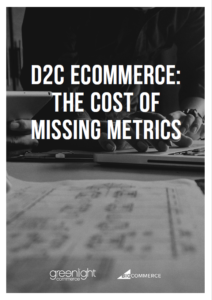At the start of 2019 we launched our first ‘Cost of Missing Metrics’ report which revealed the main pain points retailers are faced with when investing in eCommerce projects. Now, less than a year later, we have continued our quest to unearth the true state of the UK direct-to-consumer (D2C) eCommerce sector, with a second report. The results were startling.
PREPARING TO FAIL
During 2019 each D2C retailer said they each wasted approximately £174k on failed eCommerce projects and that these losses are likely to climb in 2020. It was revealed that each organisation is expected to waste £146k on poor planning and £158k on poor execution, a total of around £300k per organisation. This represents a staggering 72% increase from our earlier survey.
Planning for failure in any area of business is not an option. So why are so many D2C brands seemingly doing so?
POOR PROJECT PLANNING
One area that clearly requires an overhaul is planning. Almost half (49%) of our survey sample identified better planning to avoid failed eCommerce projects. A further 46% said better budget management was the key to improving success, while 42% highlighted better communication between departments. Given the losses experienced in 2019, and those anticipated in 2020, poor communication suggests that good planning is an afterthought rather than a fundamental pillar of success.
MISSING MEASUREMENTS
A basic tenant of any eCommerce platform is to measure measure….and measure again. If you’re not making sure the foundations are in place, and don’t know how well your platform is performing, then you can’t identify areas that need improving or why customers might be fleeing or even whether they are leaving the website.
Yet, 75% of the survey respondents admitted that they lack even the most basic of KPIs. A large majority are not even measuring abandoned carts (75%), page loading times (71%) or even ROI (74%). Yet these metrics underpin and inform the KPIs they are measuring. Failing to measure these fundamental metrics is like building a house without laying the foundations.
TOP-DOWN
The question is how can these issues be successfully addressed? Changes need to start at the top. Senior management needs to take heed of what is happening and take the lead in ensuring that projects are properly and thoroughly planned, implemented and the correct KPIs are in place.
When this word comes down from above, it carries weight and authority, is noted and acted upon. Naturally, all stakeholders must be on board, including high street stores, who agree to work together.
An important component of this phase is ensuring the right vendors, technologies and partners are in place to support D2C operations, so they are in a much better position to successfully leverage this rapidly growing market.
WHAT’S NEXT
Working with some of today’s leading retail and D2C organisations, we get to see all the forces at play when a business starts the process of upgrading its eCommerce capabilities. And with experience of delivering over 35 enterprise retail eCommerce solutions, we’ve seen a lot of common issues – and found a lot of common solutions.
At Greenlight Commerce we are dedicated to ensuring projects run smoothly, that’s why we’ve developed The Greenlight Code to address this market need. Far too many projects derail, but risk can be minimised if a measured and due diligent approach is taken.
To read the full findings, download our ‘D2C ecommerce: The Cost of Missing Metrics’ report where you will find more compelling stats and insights about the D2C retail sector.


